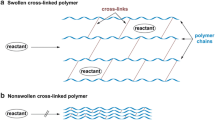Abstract
Four methoxypolyethylene glycols (MPEG, molecular masses 350, 750, 2000 and 5000 Da), each activated by nitrophenyl chloroformate, were used to modify trypsin. Compared with the native trypsin, the MPEG-modified trypsin was more stable against temperature between 30 °C and 70 °C, longer chain of MPEG moiety corresponding to higher thermal stability. The T for the native and the modified trypsin (0.4 mg ml−1) was increased from 47 °C to 66 °C. The stabilization effect caused by MPEG modification was the result of decreasing in both the autolysis rate and the thermal denaturation rate. The thermodynamic analysis of the thermal denaturation process showed that the activation free energy (ΔG*) of the native and the modified trypsin at 60 °C was increased from 102.9 to 109.3 kJ mol−1; the activation enthalpy (ΔH*) was increased from 57.4 to 86.9 kJ mol−1; the activation entropy (ΔS*) was increased from −136 to −67 J molK−1. A possible explanation for the decreased thermal denaturation rate caused by MPEG modification was also discussed.
Similar content being viewed by others
References
Basri M, Ampon K, Wan Yunus WMZ, Razak CNA, Salleh B (1995) Synthesis of fatty esters by polyethylene glycol-modified lipase. J. Chem. Tech. Biotechnol. 64: 10-16.
Bickerstaff GF, Zhou H (1993) Protease activity and autodigestion (autolysis) assays using Commassie Blue dye binding. Anal. Biochem. 210: 155-158.
Daniel RM (1996) The upper limits of enzyme thermal stability. Enzyme Microbiol. Techn. 19: 74-79.
Gaertner HF, Puigserver AJ (1992) Increased activity and stability of poly(ethylene glycol)-modified trypsin. Enzyme Microb. Technol 14: 151-155.
Garcia D, Ortega F, Marty J-L (1998) Kinetics of thermal inactivation of horseradish peroxidase: stabilizing effect of methoxypoly(ethylene glycol). Biotechnol. Appl. Biochem. 27: 49-54.
He Z, Zhang Z (1999) Solvation energy and thermal stability of hydrophilization modified α-chymotrypsin. J. Protein Chem. 18: 557-563.
Hernaiz MJ, Sanchez-Montero JM, Sinisterra JV (1999) Modification of purified lipases from Candida rugosa with polyethylene glycol: a systematic study. Enzyme Microbiol. Techn. 24: 181-190.
Inada Y, Furakawa M, Sasaki H, Kodera Y, Hiroto M, Nishimura H, Matsushima A (1995) Biomedical and biotechnological applications of PEG-and PM-modified proteins. Trends Biotechnol. 13: 86-91.
Janecek S (1993) Strategies for obtaining stable enzymes. Process Biochem. 28: 435-445.
Kawamura Y, Nakanishi K, Matsuno R, Kamikubo T (1981) Stability of immobilized α-chymotrypsin. Biotechnol. Bioeng. 23: 1219-1236.
Longo MA, Combes D (1999) Thermostability of modified enzymes: a detailed study. J. Chem. Technol. Biotechnol. 74: 25-32.
Matsumoto M, Kida K, Kondo K (1997) Effects of polyols and organic solvents on thermostability of lipase. J. Chem. Technol. Biotechnol. 70: 188-192.
Montes FJ, Battaner E, Catalan J, Galan MA (1995) Kinetics and heat-inactivation mechanisms of D-amino acid oxidase. Process Biochem. 30: 217-224.
Mozhaev VV, Siksnis VA, Melik-Nubarov NS, Galkantatte NZ, Denis GJ, Butkus EP, Zaslavsky BY, Mestechkina NM, Martinek K (1988) Protein stabilization via hydrophilization: covalent modification of trypsin and α-chymotrypsin. Eur. J. Biochem. 173: 147-154.
Murphy A, O'Fagain C (1996) Stability characteristics of chemically-modified soluble trypsin. J Biotechnol. 49: 163-171.
Robson B, Garnier J (1986) Introduction to Protein and Protein Engineering. Amsterdam: Elsevier.
Siddiqui KS, Saqib AAN, Rashid MH, Rajoka MA (1997) Thermal-stabilization of carboxymethylcellulase from Zspergillus niger by carboxyl group modification. Biotechnol. Lett. 19: 325-329.
Snyder SL, Sobocinski PZ (1975) An improved 2,4,6-trinitrobenzene-sulfonic acid method for the determination of amines. Anal. Biochem. 64: 284-288.
Veronese FM, Largajolli R, Boccu E, Schiavon O (1985) Surface modification of proteins: activation of monomethoxypolyethylene glycols by phenylchloromates and modification of ribonuclease and superoxide dismutase. Appl. Biochem. Biotechnol. 11: 141-152.
Vieille C, Zeikus JG (1996) Thermozymes: identifying molecular determinants of protein structural and functional stability. Trends Biotechnol. 14: 183-190.
Yang Z, Domach M, Auger R, Yang F, Russell AJ (1996) Polyethylene glycol-induced stabilization of subtilisin. Enzyme Microbiol. Technol. 28: 82-89.
Author information
Authors and Affiliations
Rights and permissions
About this article
Cite this article
Zhang, Z., He, Z. & Guan, G. Thermal stability and thermodynamic analysis of native and methoxypolyethylene glycol modified trypsin. Biotechnology Techniques 13, 781–786 (1999). https://doi.org/10.1023/A:1008900804320
Issue Date:
DOI: https://doi.org/10.1023/A:1008900804320




